The Spatial Distribution Characteristics of the Cultivated Land Quality in the Diluvial Fan Terrain of the Arid Region: A Case Study of Jimsar County, Xinjiang, China
Abstract
:1. Introduction
2. Research Region and Data
2.1. Overview of Research Region
2.2. Data Source and Processing
3. Research Methods
3.1. The Construction of an Index System and Identification of Weights
3.2. Computation of Cultivated Land Quality Index
- (1)
- Standardization processing of the evaluation index
- (2)
- Computation of the soil properties index, farming conditions index, and natural environment conditions index
- (3)
- Computation of the cultivated land quality
3.3. Cultivated Land Quality Index Grading
3.4. Establishment of Research Program
- (1)
- Data processing. Select cultivated land patterns in the Xinjiang cultivated land quality grade monitoring project for vectorization and the formulate soil, geographical environment, climate, cultivated land management conditions, and infrastructure database.
- (2)
- Adjust land division. Aggregate the cultivated land in terms of the principles of adjacency, administrative division, landform part, and similar slope. Unaggregated cultivated land is small-scale land (Figure 2).
- (3)
- The small-scale and large-scale cultivated land evaluation units acquire the evaluation index properties of the soil, geographical environment, climate, cultivated land management conditions, and infrastructure database and formulate two final evaluation units.
- (4)
- Based on the small-scale cultivated land evaluation unit and large-scale cultivated land evaluation unit, establish two groups of spatial interpolation programs and evaluate the cultivated land quality correspondingly as follows:
- (5)
- When the special interpolation method and evaluation unit scale are identified, utilize ArcGIS to compute the indexes of all the dimensions and cultivated land quality within the scope of the research region, complete the index grading, and formulate the cultivated land quality comprehensive evaluation results.
3.5. Validation of the Spatial Interpolation Method and Evaluation Accuracy
3.6. Determination of the Spatial Interpolation Group and Validation Group
4. Results Analyses
4.1. Evaluation of the Unit Scale and Spatial Interpolation Method Selection
4.2. Characteristics of the Cultivated Land Quality Grades in the Diluvial Fan Terrain and Spatial Distribution
4.2.1. Characteristics of the Three Dimensions Grades and Spatial Distribution
4.2.2. Characteristics of Cultivated Land Quality Grades and Spatial Distribution
4.3. Characteristics of Cultivated Land Quality Grades of Different Parts of Diluvial Fan and Spatial Distribution
4.3.1. Characteristics of Cultivated Land Quality Grades at Piedmont Slope
4.3.2. Characteristics of the Cultivated Land Quality Grades at Upper Part of the Diluvial Fan
4.3.3. Characteristics of the Cultivated Land Quality Grades at Middle Part of the Diluvial Fan
4.3.4. Characteristics of the Cultivated Land Quality Grades at the Lower Part of the Diluvial Fan
4.3.5. Characteristics of the Cultivated Land Quality at Edge of the Diluvial Fan
4.3.6. Spatial Distribution Characteristics of the Cultivated Land Quality Grades at Different Parts of the Diluvial Fan
- (1)
- Soil properties: edge of the diluvial fan (4.78) > lower part of the diluvial fan (5.53) > middle part of the diluvial fan (5.15) > upper part of the diluvial fan (4.89) > piedmont slope (5.61) (Figure 13).
- (2)
- Farming conditions: middle part of the diluvial fan (5.276) > piedmont slope (5.286) > upper part of the diluvial fan (5.287) > edge of the diluvial fan (5.883) > lower part of the diluvial fan (6.251) (Figure 13).
- (3)
- Natural environment conditions: edge of the diluvial fan (3.61) > lower part of the diluvial fan (4.83) > middle part of the diluvial fan (4.87) > upper part of the diluvial fan (5.35) > piedmont slope (5.77) (Figure 13).
- (4)
- Cultivated land quality grade: edge of the diluvial fan (5.72) > lower part of the diluvial fan (6.75) > upper part of the diluvial fan (6.42) > middle part of the diluvial fan (6.23) > piedmont slope (6.87) (Figure 13). According to the sequence, the cultivated land quality stays at the middle and lower levels. As the altitude of the diluvial fan part rises, the cultivated land quality tends to decline, indicating a vertical zonality differentiation rule.
5. Discussion
5.1. The Construction of the Evaluation Index System
5.2. Evaluation Accuracy
5.3. Improvement of Cultivated Land Quality
- (1)
- Through the long-term application of organic fertilizer and straw returning to the field, the increase of soil organic matter and the improvement of soil fertility can be realized. Peel off the barren soil on the surface of the cultivated land at the piedmont slope and upper part of the diluvial fan and backfill with high-quality soil removed from other places; combine the long-term increasing application of organic fertilizer and deep ploughing, cultivate alkali-resisting crops, cooperatively use chemical ameliorants to improve the salt and alkali soil and pH effectively, and increase the microelements in the soil (Figure 14).
- (2)
- Carrying out a land consolidation project. Transform and pave roads to improve accessibility; plant windbreaks to protect crops growing and reduce evaporation caused by wind, level the cultivated land at the piedmont slope and upper part of the diluvial fan to improve the farming suitability, integrate the finely divided cultivated land and carry out and carry out the scale operation (Figure 14).
- (3)
- Cultivated land at the piedmont slope and upper part of the diluvial fan with poor quality and a poor anticipated improvement effect shall be returned to forestry or grassland or be fallow; lay out dripping irrigation and relevant water-saving irrigation equipment to promote the establishment of highly efficient water-saving irrigation projects; and control the total amount of water consumption and determine the land cultivated with the water amount to guarantee the continuous recovery of the underground water level (Figure 14).
6. Conclusions
Supplementary Materials
Author Contributions
Funding
Institutional Review Board Statement
Informed Consent Statement
Data Availability Statement
Conflicts of Interest
Appendix A
Appendix B
References
- Yuan, X.; Shao, Y.; Li, Y.; Liu, Y.; Wang, Y.; Wei, X.; Wang, X.; Zhao, Y. Cultivated land quality improvement to promote revitalization of sandy rural areas along the Great Wall in northern Shaanxi Province, China. J. Rural Stud. 2019, in press. [Google Scholar] [CrossRef]
- Liu, Y.; Qiao, L. Innovating system and policy of arable land conservation under the new-type urbanization in China. Econ. Geogr. 2014, 34, 1–6. (In Chinese) [Google Scholar]
- Kong, X. China must protect high-quality arable land. Nature 2014, 506, 7. [Google Scholar] [CrossRef] [PubMed]
- Zhou, Y.; Li, X.; Liu, Y. Cultivated land protection and rational use in China. Land Use Policy 2021, 106, 105454. [Google Scholar] [CrossRef]
- Liu, Y.; Zhang, Y.; Guo, L. Towards realistic assessment of cultivated land quality in an ecologically fragile environment: A satellite imagery-based approach. Appl. Geogr. 2010, 30, 271–281. [Google Scholar] [CrossRef]
- Sheng, R.; Chen, M.; Kong, X.; Li, Y.; Tong, Y.; Wang, J.; Li, T.; Lu, M. Conception and evaluation of quality of arable land and strategies for its management. Acta Pedol. Sin. 2012, 49, 1210–1217. (In Chinese) [Google Scholar]
- Chen, Y.; Li, B.; Fan, Y.; Sun, C.; Fang, G. Hydrological and water cycle processes of inland river basins in the arid region of Northwest China. J. Arid Land 2019, 11, 161–179. [Google Scholar] [CrossRef] [Green Version]
- Thenkabail, P.S.; Hanjra, M.A.; Dheeravath, V.; Gumma, M. A holistic view of global croplands and their water use for ensuring global food security in the 21st century through advanced remote sensing and non-remote sensing approaches. Remote Sens. 2010, 2, 211–261. [Google Scholar] [CrossRef] [Green Version]
- Ministry of Land and Resources of China. Main Data Results of National Cultivated Land Quality Grade Updated Evaluation in 2015; Ministry of Land and Resources of China: Beijing, China, 2017. (In Chinese)
- Li, W.; Wang, D.; Li, H.; Liu, S. Urbanization-induced site condition changes of peri-urban cultivated land in the black soil region of northeast China. Ecol. Indic. 2017, 80, 215–223. [Google Scholar] [CrossRef]
- Liu, X.; Zhao, C.; Song, W. Review of the evolution of cultivated land protection policies in the period following China’s reform and liberalization. Land Use Policy 2017, 67, 660–669. [Google Scholar] [CrossRef]
- Zhang, R.; Zheng, H.; Liu, Y. Evaluation on cultivated land ecological security based on the PSR model and matter element analysis. Acta Ecol. Sin. 2013, 33, 5090–5100. (In Chinese) [Google Scholar] [CrossRef]
- Guo, R.; Yang, M.; Shen, J. Evaluation for ecological security of cultivated land in Chang-Zhu-Tan region. Trans. Chin. Soc. Agric. Mach. 2016, 47, 193–201. (In Chinese) [Google Scholar]
- Burghardt, W.; Heintz, D.; Hocke, N. Soil fertility characteristics and organic carbon stock in soils of vegetable gardens compared with surrounding arable land at the center of the urban and industrial area of Ruhr, Germany. Eurasian Soil Sci. 2018, 51, 1067–1079. [Google Scholar] [CrossRef]
- Zhang, H.; Yuan, X.; Xiong, T.; Wang, H.; Jiang, L. Bioremediation of co-contaminated soil with heavy metals and pesticides: Influence factors, mechanisms and evaluation methods. Chem. Eng. J. 2020, 398, 125657. [Google Scholar] [CrossRef]
- Liu, S.; Qin, T.; Dong, B.; Shi, X.; Lv, Z.; Zhang, G. The influence of climate, soil properties and vegetation on soil nitrogen in sloping farmland. Sustainability 2021, 13, 1480. [Google Scholar]
- Wen, L.; Kong, X.; Zhang, B.; Sun, X.; Xin, Y.; Zhang, P. Construction and application of arable land quality evaluation system based on sustainable development demand. CSAE 2019, 35, 234–242. (In Chinese) [Google Scholar]
- Hu, K.; Shi, P. Evaluation and study on quality of cultivated land in gansu province. China Land Sci. 2008, 22, 38–43. [Google Scholar]
- Sun, X.; Kong, X.; Wen, L. Evaluation index system of cultivated Land quality and its development trend based on cultivated land Elements. Chin. J. Soil Sci. 2019, 50, 739–747. (In Chinese) [Google Scholar]
- Xin, Y.; Fan, S.; Kong, X.; Zhang, B.; Wen, L.; Zhang, Q. Evaluation of cultivated land quality based on four quality dimensions. Resour. Sci. 2018, 40, 737–747. (In Chinese) [Google Scholar]
- Liu, L. The Discipline of Land Resources, 5th ed.; China Agricultural University Press: Beijing, China, 2010; pp. 1–4. (In Chinese) [Google Scholar]
- Ma, Q.; Dong, B.; Xu, W.; Cai, L.; Wu, J. Evaluation of cultivated land quality and analysis of soil nutrients and salinization in arid areas: Taking Minqin Oasis as an example. Arid Land Geogr. 2021, 44, 214–524. (In Chinese) [Google Scholar]
- Kong, X.; Zhang, B.; Wen, L.; Hu, Y.; Lei, M.; Yao, J.; Xin, Y. Theoretical framework and research trends of cultivated land quality based on elements-process-function. China Land Sci. 2018, 32, 14–20. (In Chinese) [Google Scholar]
- Wei, X.; Wang, S.; Yuan, X.; Wang, X.; Zhang, B. Spatial and temporal changes and its variation of cultivated land quality in Shanxi province. CSAE 2018, 34, 240–248. (In Chinese) [Google Scholar]
- Zhao, C.; Zhou, Y.; Jiang, J.; Xiao, P.; Wu, H. Spatial characteristics of cultivated land quality accounting for ecological environmental condition: A case study in hilly area of northern Hubei province, China. Sci. Total Environ. 2021, 774, 145765. [Google Scholar] [CrossRef]
- Tan, Y.; Chen, H.; Lian, K.; Yu, Z. Comprehensive evaluation of cultivated land quality at county scale: A case study of Shengzhou, Zhejiang province, China. Int. J. Environ. Res. Public Health 2020, 17, 1169. [Google Scholar] [CrossRef] [Green Version]
- Tuson, M.; Yap, M.; Kok, M.R.; Murray, K.; Turlach, B.; Whyatt, D. Incorporating geography into a new generalized theoretical and statistical framework addressing the modifiable areal unit problem. Int. J. Health Geogr. 2019, 18, 6. [Google Scholar] [CrossRef] [PubMed] [Green Version]
- Lee, S.-I.; Lee, M.; Chun, Y.; Griffith, D.A. Uncertainty in the effects of the modifiable areal unit problem under different levels of spatial autocorrelation: A simulation study. Int. J. Geogr. Inf. Sci. 2019, 33, 1135–1154. [Google Scholar] [CrossRef]
- Moat, J.; Bachman, S.P.; Field, R.; Boyd, D.S. Refining area of occupancy to address the modifiable areal unit problem in ecology and conservation. Conserv. Biol. 2018, 32, 1278–1289. [Google Scholar] [CrossRef]
- Hennerdal, P.; Nielsen, M.M. A multiscalar approach for identifying clusters and segregation patterns that avoids the modifiable areal unit problem. Ann. Am. Assoc. Geogr. 2017, 107, 555–574. [Google Scholar] [CrossRef]
- Taylor, C.; Gorard, S.; Fitz, J. The modifiable areal unit problem: Segregation between schools and levels of analysis. Int. J. Soc. Res. Methodol. 2003, 6, 41–60. [Google Scholar] [CrossRef]
- Nelson, J.K.; Brewer, C.A. Evaluating data stability in aggregation structures across spatial scales: Revisiting the modifiable areal unit problem. Cartogr. Geogr. Inf. Sci. 2017, 44, 35–50. [Google Scholar] [CrossRef]
- Lechner, A.M.; Langford, W.T.; Jones, S.D.; Bekessy, S.A.; Gordon, A. Investigating species—Environment relationships at multiple scales: Differentiating between intrinsic scale and the modifiable areal unit problem. Ecol. Complex. 2012, 11, 91–102. [Google Scholar] [CrossRef]
- Chen, Y.; Li, Z.; Fan, Y.; Wang, H.; Fang, G. Research progress on the impact of climate change on water resources in the arid region of Northwest China. Acta Geogr. Sin. 2014, 69, 1295–1304. (In Chinese) [Google Scholar]
- Chen, Y.; Yang, Q.; Luo, Y.; Shen, Y.; Pan, X.; Li, L.; Li, Z. Ponder on the issues of water resources in the arid region of northwest China. Arid Land Geogr. 2012, 35, 1–9. (In Chinese) [Google Scholar]
- Wang, H.; Chen, Y.; Xun, S.; Lai, D.; Fan, Y.; Li, Z. Changes in daily climate extremes in the arid area of northwestern China. Theor. Appl. Climatol. 2013, 112, 15–28. [Google Scholar] [CrossRef]
- Wu, M.; Wang, H.; Sun, G.; Xu, C. Formation and risk analysis of meteorological disasters in Xinjiang. Arid Land Geogr. 2016, 39, 1212–1220. (In Chinese) [Google Scholar]
- Natural Resources Department of Xinjiang. Report on Monitoring Cultivated Land Quality Grade of Xinjiang; Natural Resources Department of Xinjiang: Urumchi, China, 2018. (In Chinese)
- Gao, G. Low hilly land extraction method based on ArcGIS. Geomat. Spat. Inf. Technol. 2014, 37, 113–114. (In Chinese) [Google Scholar]
- Liu, R.; Wang, H.; Quan, F. The contributing ratio of natural and social-economic factors to the quality of cultivated land. Chin. J. Soil Sci. 2005, 36, 289–294. (In Chinese) [Google Scholar]
- Gu, Z.; Shao, X.; Qian, W.; Huang, C.; Lu, J.; Li, Y.; Huang, B.; Zhang, H. Quantitative evaluation of soil productivity of farmland in Zhangjiagang city Jiangsu province and its significance. Acta Pedol. Sin. 2007, 44, 354–359. (In Chinese) [Google Scholar]
- Störrle, M.; Hagedorn, L.; Yurtaev, A.; Brauckmann, H.-J.; Broll, G. Soil structure of arable and non-arable land in the Western Siberian Grain Belt in Russia—Application of the soil fingerprint code for topsoil characterization. J. Plant. Nutr. Soil Sci. 2016, 179, 510–519. [Google Scholar] [CrossRef]
- Liu, L.; Zhou, D.; Chang, X.; Lin, Z. A new grading system for evaluating China’s cultivated land quality. Land Degrad. Dev. 2020, 31, 1482–1501. [Google Scholar] [CrossRef]
- Shi, S.; Chen, Y.; Yao, Y.; Li, Z.; He, Y. Impact assessment of cultivated land change upon crain productive capacity in Northeast China. Acta Geogr. Sin. 2008, 6, 574–586. (In Chinese) [Google Scholar]
- Shi, S.; Chen, Y.; Yao, Y.; Li, Z.; He, Y. Assessing natural quality and use quality of cultivated land in Northeast China. Resour. Sci. 2008, 30, 378–384. (In Chinese) [Google Scholar]
- General Administration of Quality Supervision, Inspection and Quarantine of the People’s Republic of China; Standardisation Administration of the People’s Republic of China. Regulation for Gradation on Agriculture Land Quality; China Standard Press: Beijing, China, 2012. (In Chinese) [Google Scholar]
- General Administration of Quality Supervision, Inspection and Quarantine of the People’s Republic of China; Standardisation Administration of the People’s Republic of China. Rules for Grading of Agricultural Land; China Standard Press: Beijing, China, 2012. (In Chinese) [Google Scholar]
- General Administration of Quality Supervision, Inspection and Quarantine of the People’s Republic of China; Standardisation Administration of the People’s Republic of China. Cultivated Land Quality Grade; China Standard Press: Beijing, China, 2012. (In Chinese) [Google Scholar]
- Yang, P.; Xia, J.; Zhang, Y.; Zhan, C.; Cai, W.; Zhang, S.; Wang, W. Quantitative study on characteristics of hydrological drought in arid area of Northwest China under changing environment. J. Hydrol. 2021, 597, 126343. [Google Scholar] [CrossRef]
- Bie, Q.; Xie, Y. The constraints and driving forces of oasis development in arid region: A case study of the Hexi Corridor in northwest China. Sci. Rep. 2020, 10, 17708. [Google Scholar] [CrossRef] [PubMed]
- Zhang, W.-Q.; Xi, Z.-L. Application of Delphi method in screening of indexes for measuring soil pollution value evaluation. Environ. Sci. Pollut. Res. 2021, 28, 6561–6571. [Google Scholar] [CrossRef]
- Liang, R.; Song, S.; Shi, Y.; Shi, Y.; Lu, Y.; Zheng, X.; Xu, X.; Wang, Y.; Han, X. Comprehensive assessment of regional selenium resources in soils based on the analytic hierarchy process: Assessment system construction and case demonstration. Sci. Total Environ. 2017, 605–606, 618–625. [Google Scholar] [CrossRef] [PubMed]
- Li, S.; Cai, Y. Some scaling issues of geography. Geogr. Res. 2005, 24, 11–18. (In Chinese) [Google Scholar]
- Meng, B.; Wang, J. A review on the methodology of scaling with geo-data. Acta Geogr. Sin. 2005, 60, 277–288. (In Chinese) [Google Scholar]
- Crang, M.; Cook, I. Concepts and Techniques in Modern Geography; Environmental Publications, University of East Anglia: Norwich, UK, 1995. [Google Scholar]
- Qi, C.; Diao, J.; Qiu, L. On estimating model in feature selection with cross-validation. IEEE Access 2019, 7, 33454–33463. [Google Scholar] [CrossRef]
- Bergmeir, C.; Hyndman, R.J.; Koo, B. A note on the validity of cross-validation for evaluating autoregressive time series prediction. Comput. Stats Data Anal. 2018, 120, 70–83. [Google Scholar] [CrossRef]
- Shi, Y.; Duan, W.; Fleskens, L.; Li, M.; Hao, J. Study on evaluation of regional cultivated land quality based on resource-asset-capital attributes and its spatial mechanism. Appl. Geogr. 2020, 125, 102284. [Google Scholar] [CrossRef]
- Cheng, Q.; Guo, Y.; Wang, W.; Hao, S. Spatial variation of soil quality and pollution assessment of heavy metals in cultivated soils of Henan Province, China. Chem. Speciat. Bioavailab. 2014, 26, 184–190. [Google Scholar] [CrossRef] [Green Version]
- Kuang, L.; Ye, Y.; Zhao, X.; Guo, X.; Xie, W. Evaluation on influence of land consolidation project on cultivated land quality based on agricultural land classification correction method. CSAE 2016, 32, 198–205. (In Chinese) [Google Scholar]
- Qian, F.; Wang, Q.; Bian, Z.; Dong, X.; Zheng, L. Farmland quality evaluation and site assessment in Lingyuan city. CSAE 2011, 27, 325–329. (In Chinese) [Google Scholar]
- Sun, C.; Bi, C.; Chen, Z.; Wang, D.; Zhang, C.; Sun, Y.; Yu, Z.; Zhou, D. Assessment on environmental quality of heavy metals in agricultural soils of Chongming Island, Shanghai City. J. Geogr. Sci. 2010, 20, 137–149. [Google Scholar] [CrossRef]
- Wang, W.; Wang, Y.; Zhao, B. Quality, environment and system construction of ultivated land in Liooning province. Chin. J. Soil Sci. 2003, 4, 362–365. (In Chinese) [Google Scholar]
- Wang, M.; Tian, F.; He, X.; Bao, Y. Cultivated land quality evaluation in the Three Gorges reservoir area. Mt. Res. 2017, 35, 556–565. (In Chinese) [Google Scholar]
- Huang, X.; Li, Y.; Feng, J.; Wang, J.; Wang, Z.; Wang, S.; Zhang, Y. Climate characteristics of precipitation and extreme drought events in Northwest China. Acta Ecol. Sin. 2015, 35, 1359–1370. (In Chinese) [Google Scholar]
- Jia, B.; Ci, L.; Han, D.; Yang, J. Research progress and prospect on the monitoring and early warning and mitigation technology of meteorological drought disaster in northwest China. Adv. Earth Sci. 2000, 30, 381–388. (In Chinese) [Google Scholar]
- Qi, Y.; Darilek, J.L.; Huang, B.; Zhao, Y.; Sun, W.; Gu, Z. Evaluating soil quality indices in an agricultural region of Jiangsu Province, China. Geoderma 2009, 149, 325–334. [Google Scholar] [CrossRef]
- Song, X.; Zhu, O.; Li, Y.; Li, F. Cultivated land use change in China, 1999–2007: Policy development perspectives. J. Geogr. Sci. 2012, 22, 1061–1078. [Google Scholar] [CrossRef]
- Qin, Y.; Zhao, G.; Dong, C.; Tang, X.; Xu, G.; Han, J. Comprehensive evaluation and spatio-temporal variation analysis of cultivated land quality at town scale. J. Nat. Resour. 2010, 25, 454–464. (In Chinese) [Google Scholar]
- Kolaczyk, E.D.; Huang, H. Multiscale statistical models for hierarchical spatial aggregation. Geogr. Anal. 2001, 33, 95–118. [Google Scholar] [CrossRef]
- Qi, L.; Bai, Y. MAUP effects on the detection of spatial hot spots in socio-economic statistical data. Acta Geogr. Sin. 2012, 67, 1317–1326. (In Chinese) [Google Scholar]
- Chen, J.; Zhang, Y.; Yu, J. Effect of MAUP in spatial autocorrelation. Acta Geogr. Sin. 2011, 66, 1597–1606. (In Chinese) [Google Scholar]
- Ma, H.; Yu, T.; Yang, Z.; Hou, Q.; Zeng, Q.; Wang, R. Spatial interpolation methods and pollution assessment of heavy metals of soil in typical areas. Environ. Sci. 2018, 39, 4684–4693. (In Chinese) [Google Scholar]
- Xiao, L.; Luo, G.; Chen, X.; Xu, W. Study on the temporal and spatial change of shallow groundwater beneath the alluvial-diluvial plain oasis in arid regions. Arid Land Geogr. 2005, 2, 225–228. (In Chinese) [Google Scholar]
- Gu, F.; Zhang, Y.; Pan, X.; Chu, Y.; Shi, Q. Interaction of land use change and spatial and temporal dynamics of soil moisture and salinity in arid land. Acta Geogr. Sin. 2003, 58, 845–853. (In Chinese) [Google Scholar]
- Chen, W.; Kong, X.; Liao, Y.; Wang, X.; Song, F.; Weng, L.; Zhang, B. Evaluation of cultivated land quality in the loess plateau: A case study of Yanchuan county, Shaanxi province. Res. Soil Water Conserv. 2021, 28, 375–381. (In Chinese) [Google Scholar]
- Xue, R.; Wang, C.; Liu, M.; Zhang, D.; Li, K.; Li, N. A new method for soil health assessment based on analytic hierarchy process and meta-analysis. Sci. Total Environ. 2018, 650, 2771–2777. [Google Scholar] [CrossRef] [PubMed]
- Shao, W.; Guan, Q.; Tan, Z.; Luo, H.; Ma, Y. Application of BP-ANN model in evaluation of soil quality in the arid area, northwest China. Soil Tillage Res. 2021, 208, 104907. [Google Scholar] [CrossRef]
- Zhao, J.; Zhang, H.; Wang, Y.; Qiao, Z.; Hou, G. Research on the quality evaluation of cultivated land in provincial area based on AHP and GIS: A case study in Jilin province. Chin. J. Soil Sci. 2012, 43, 70–75. (In Chinese) [Google Scholar]
- Chen, C.; Lin, C. Cultivated land quality assessment and protection zoning in Southern Jiangsu. Resour. Environ. Yangtze Basin 2016, 25, 1860–1869. (In Chinese) [Google Scholar]
- Xiao, D.; Chen, W.; Guo, F. On the basic concepts and contents of ecological security. Chin. J. Appl. Ecol. 2002, 13, 354–358. (In Chinese) [Google Scholar]



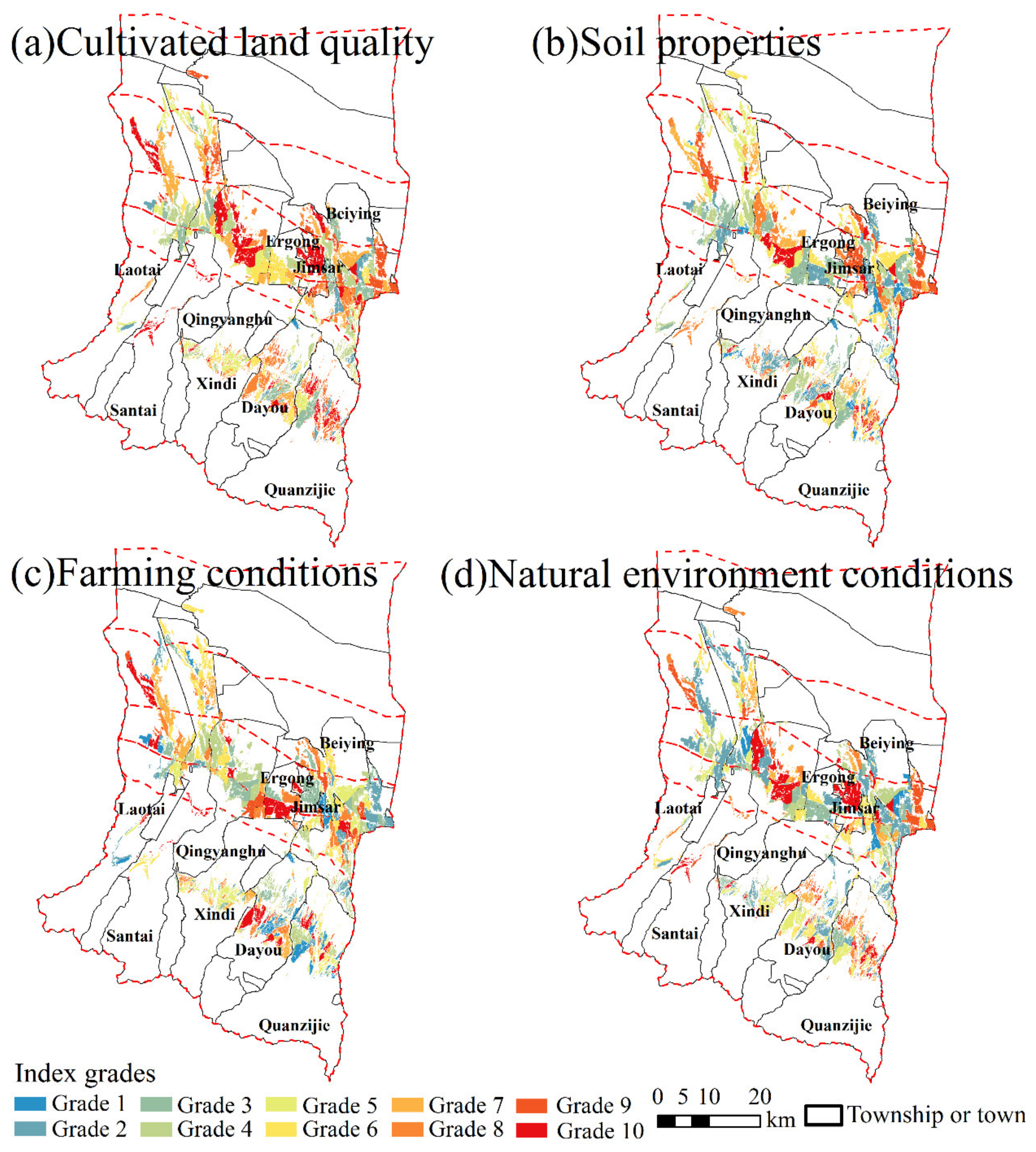
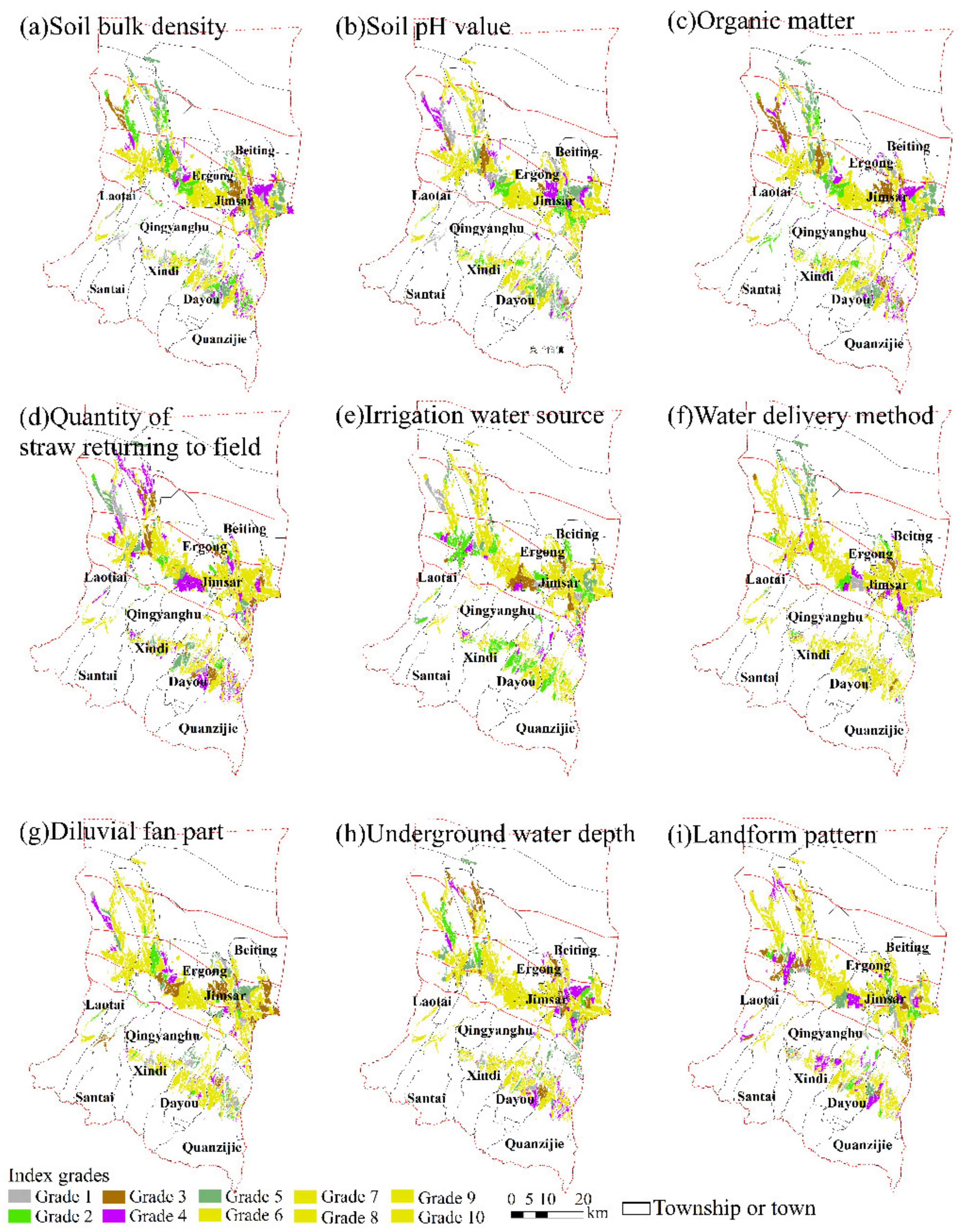
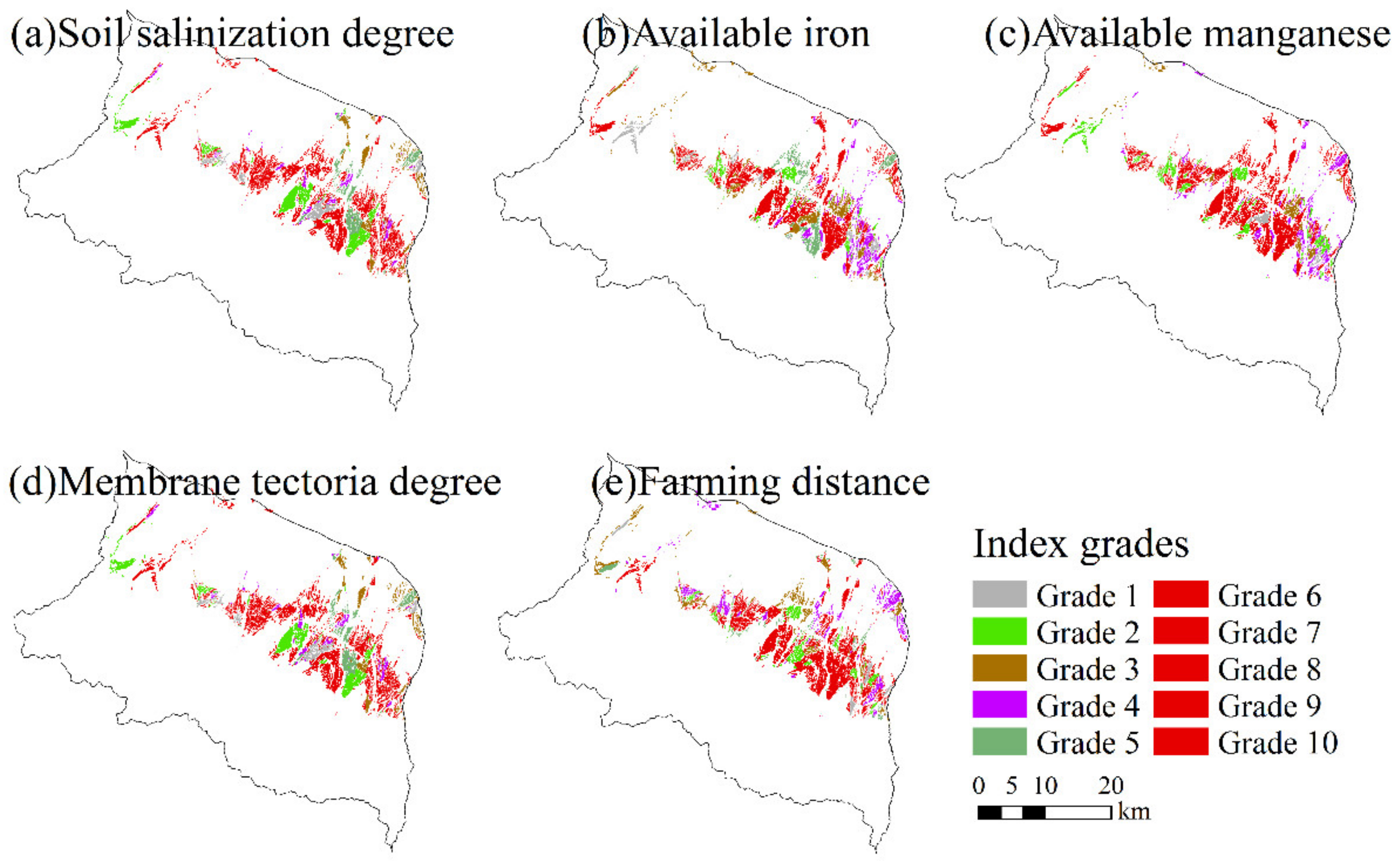

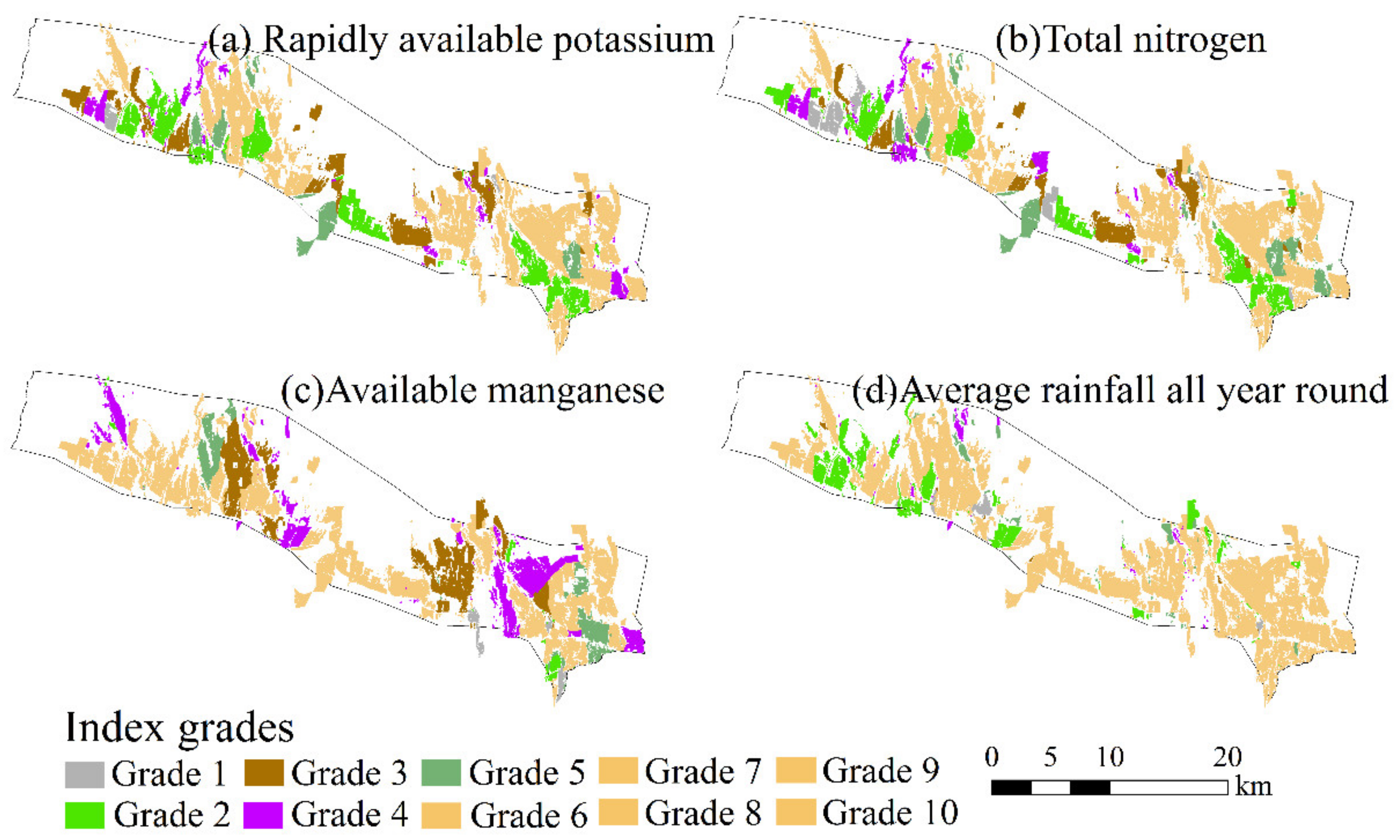
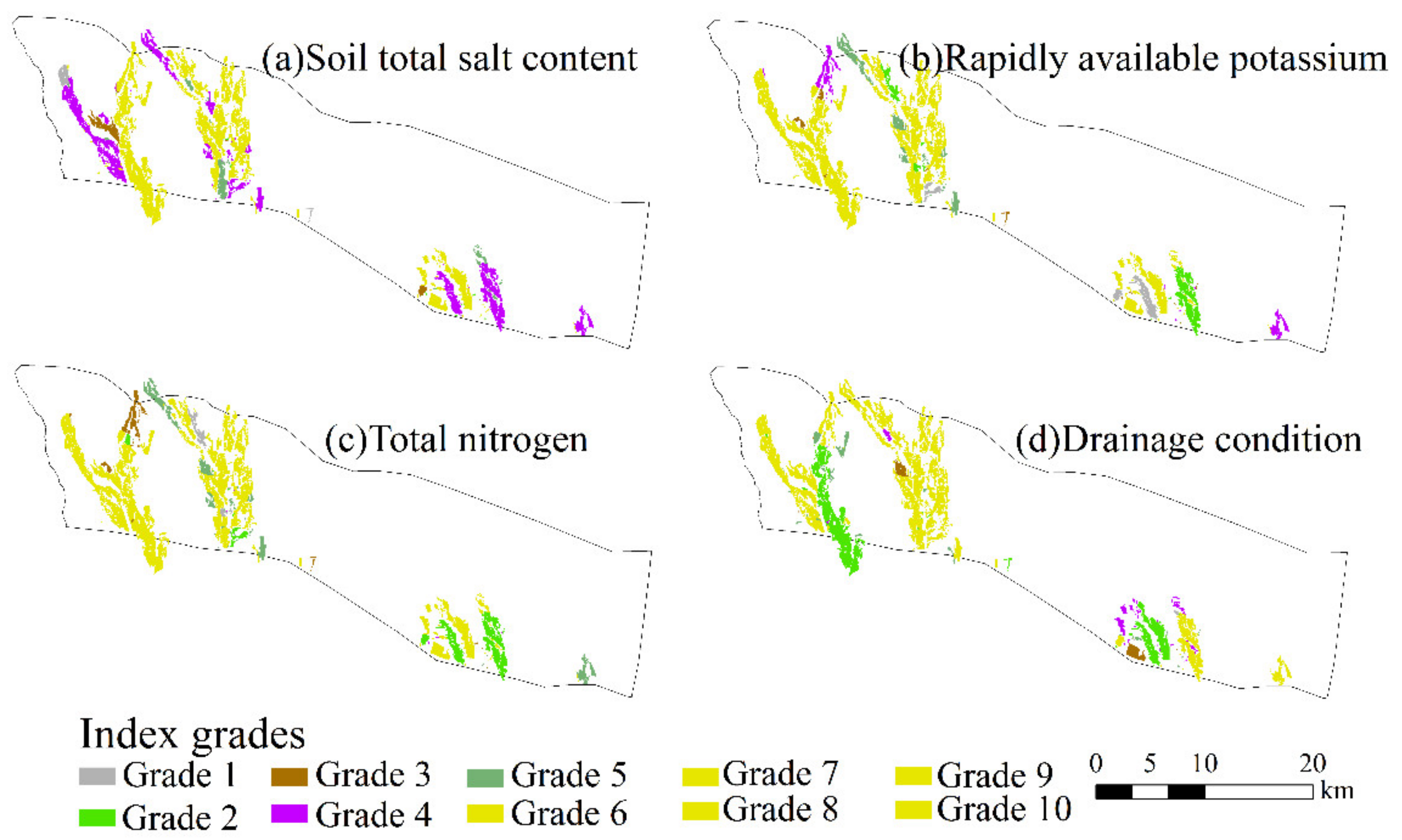
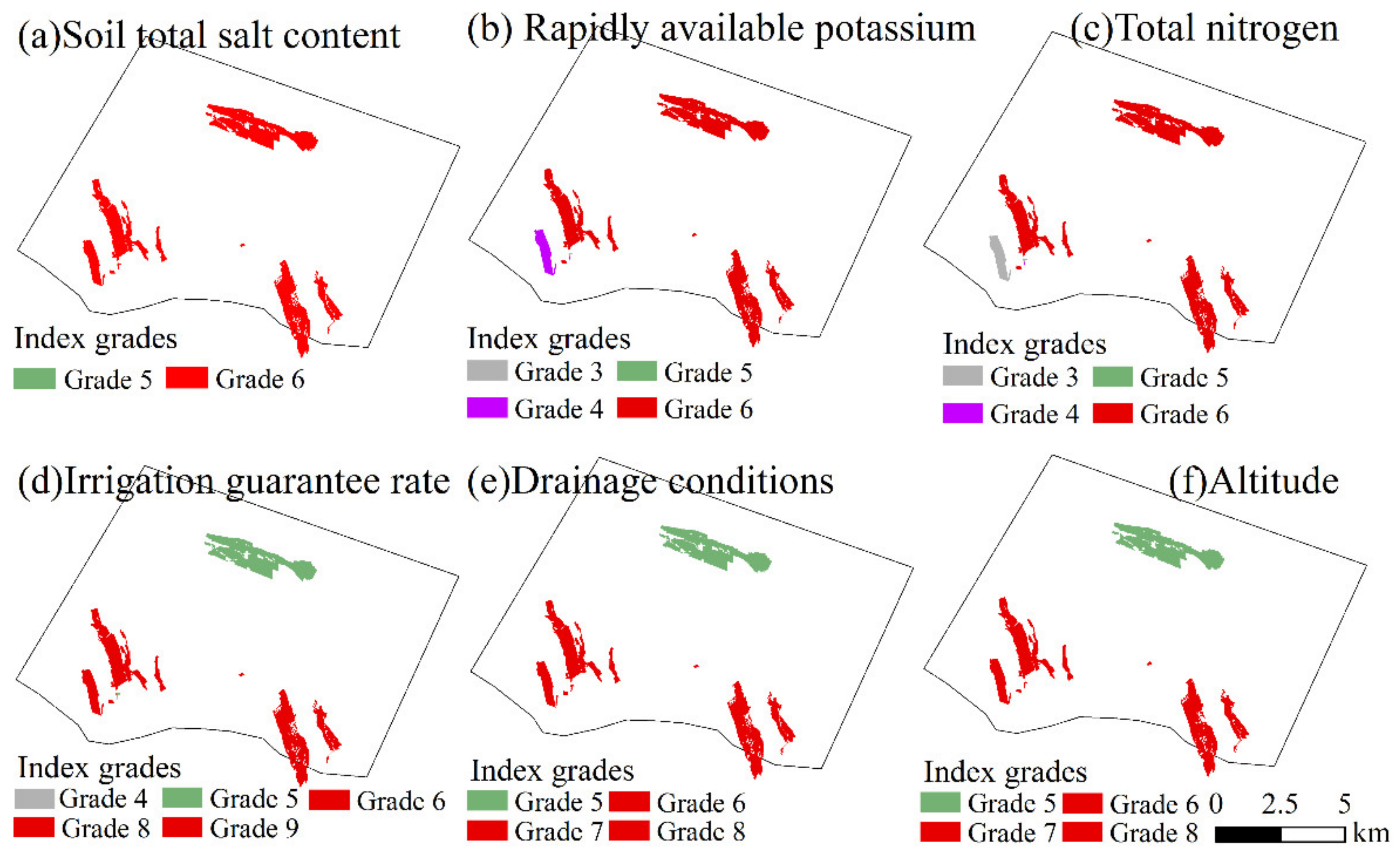

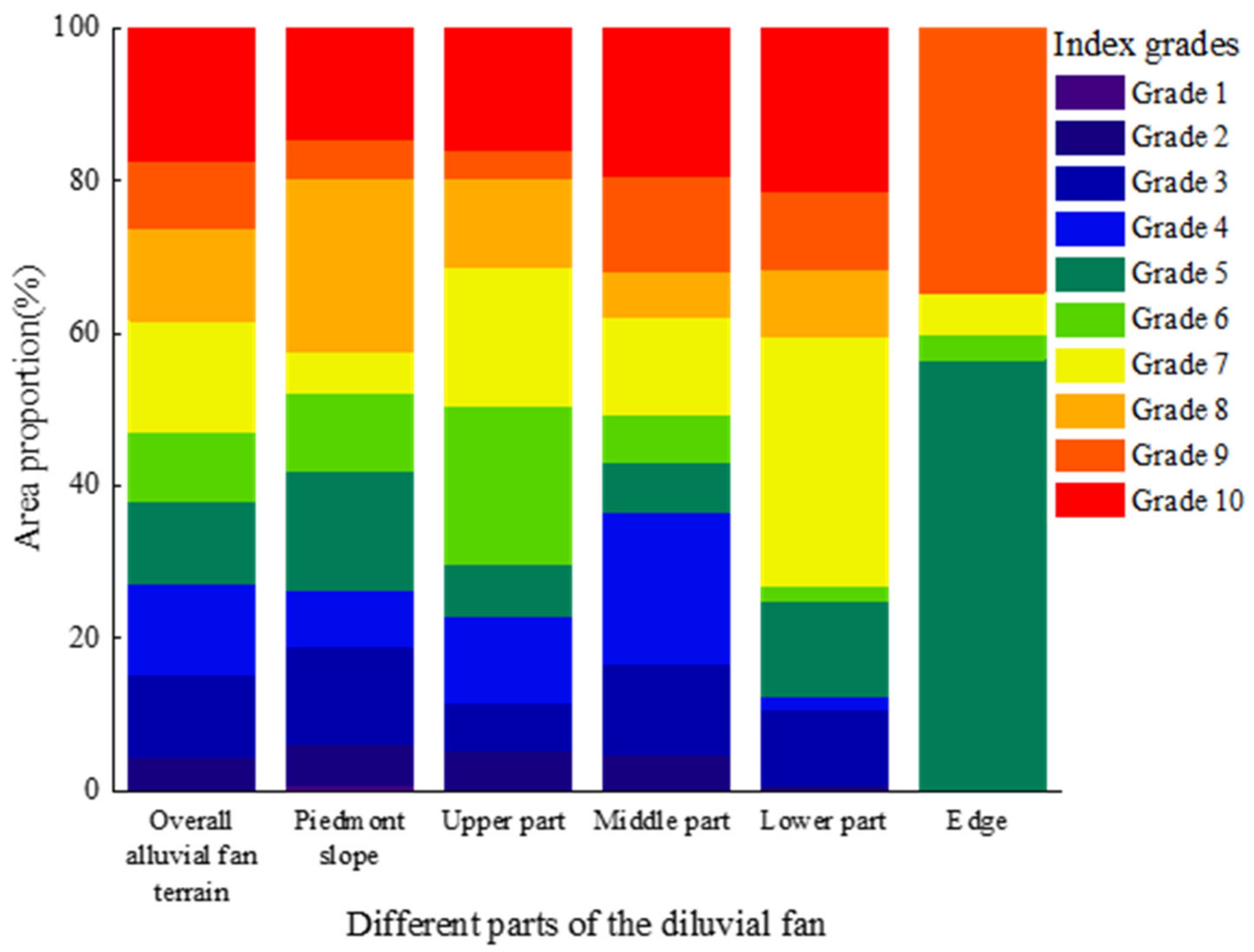
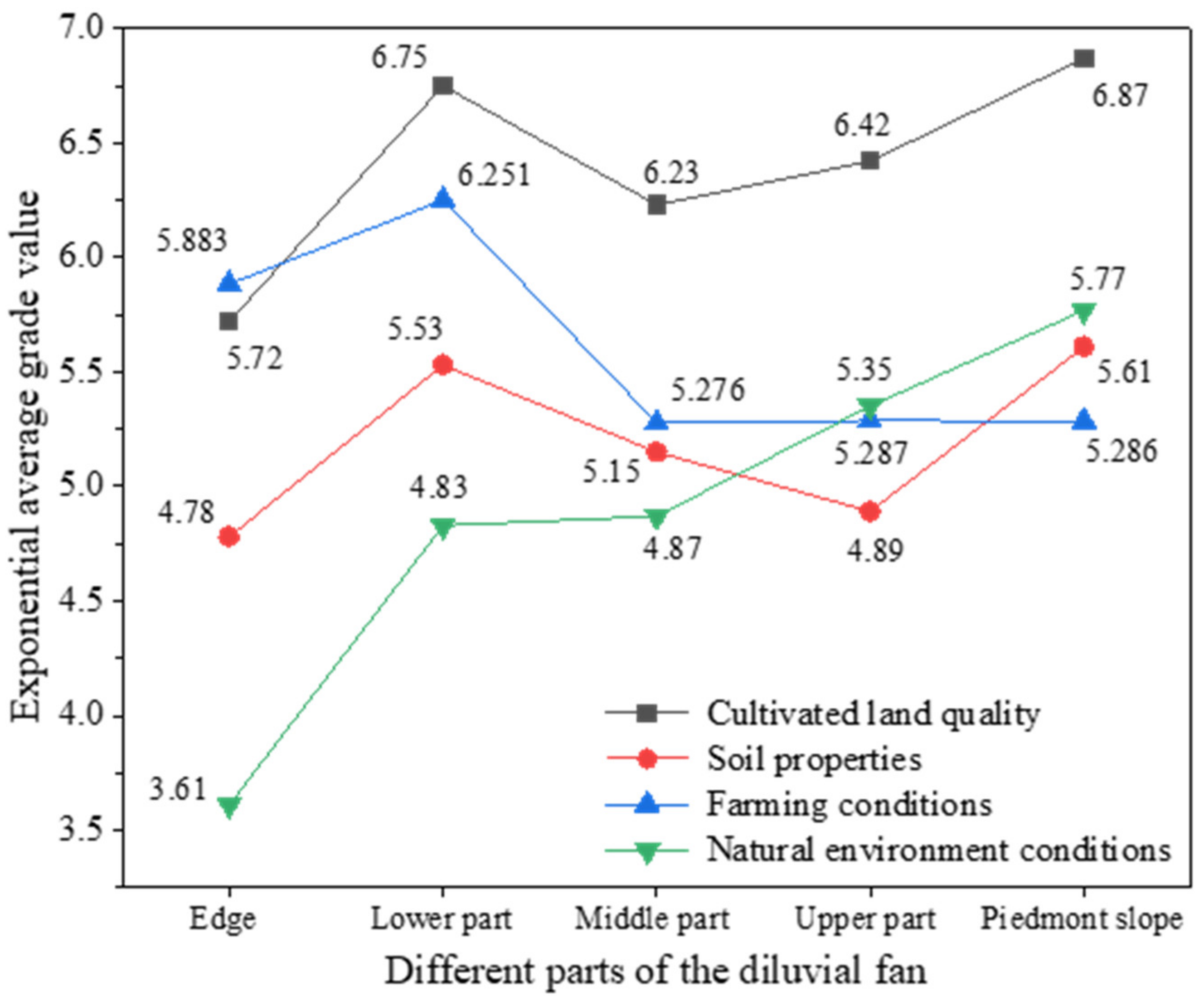
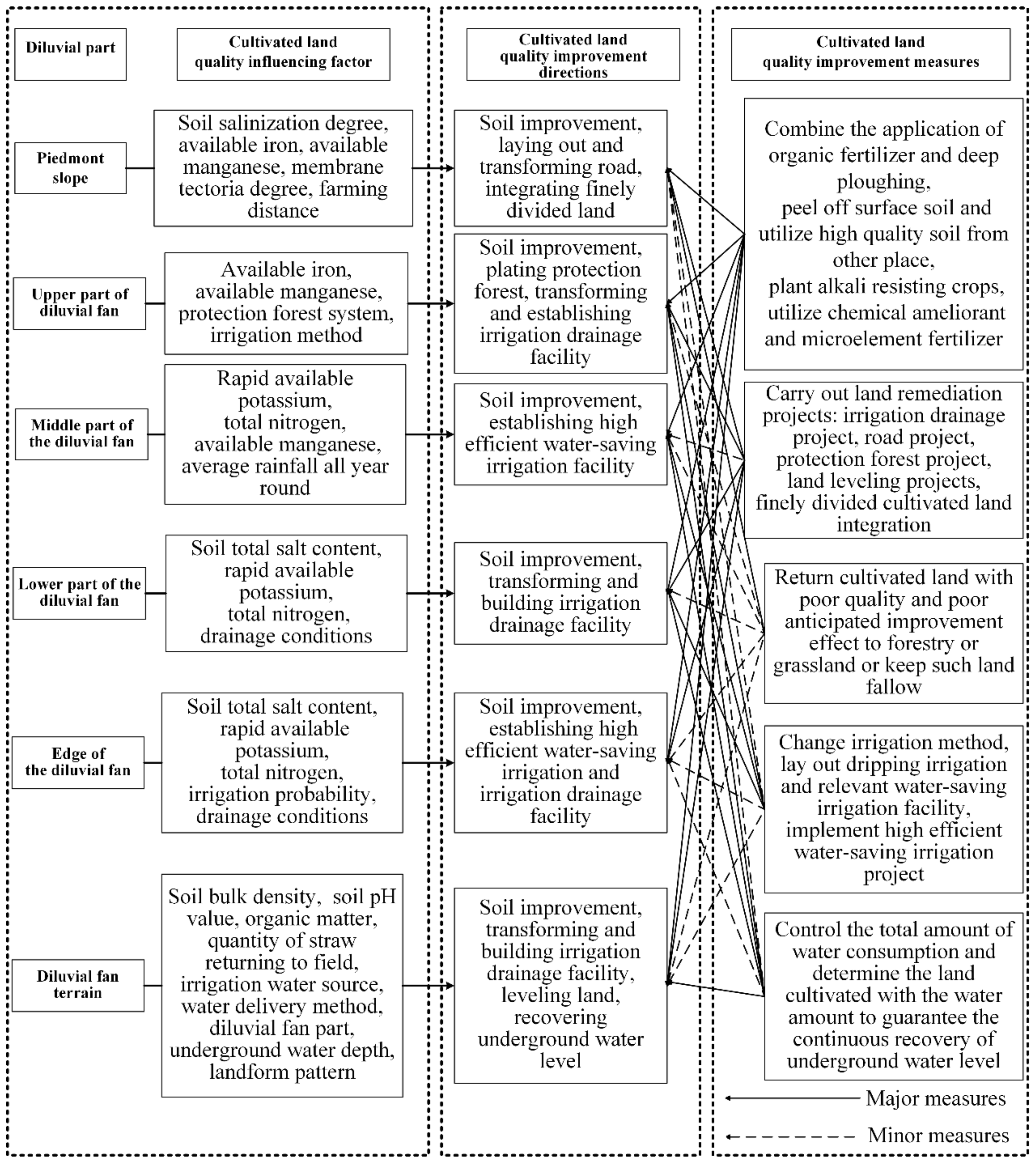
| Dimension | First Grade Index | Second Grade Index | Index Weight | Index Property |
|---|---|---|---|---|
| Soil properties (S) | Soil physical and chemical properties | Effective soil layer thickness | 0.0312 | + |
| Soil salinization degree | 0.1060 | − | ||
| Soil barrier layer depth | 0.0815 | ± | ||
| Soil capacity | 0.0528 | ± | ||
| Surface soil texture | 0.0395 | ± | ||
| Soil pH value | 0.1029 | − | ||
| Total soil salt | 0.0862 | − | ||
| Soil nutrient status | Organic matter | 0.0913 | + | |
| Rapidly available phosphorus | 0.0251 | + | ||
| Rapidly available potassium | 0.0194 | + | ||
| Total nitrogen | 0.0677 | + | ||
| Available copper | 0.0158 | + | ||
| Available iron | 0.0892 | + | ||
| Available zinc | 0.0368 | + | ||
| Available manganese | 0.0956 | + | ||
| Available boron | 0.0473 | + | ||
| Available molybdenum | 0.0119 | + | ||
| Farming conditions (C) | Management conditions | Agricultural infrastructure matching degree a | 0.1265 | + |
| Protection forest system b | 0.0837 | + | ||
| Quantity of straw returning to field c | 0.0633 | + | ||
| Membrana tectoria degree d | 0.1171 | ± | ||
| Farming distance e | 0.1094 | ± | ||
| Irrigation water conditions | Irrigation guarantee rate f | 0.1391 | + | |
| Drainage conditions g | 0.0656 | + | ||
| Irrigation method h | 0.0958 | ± | ||
| Irrigation water source i | 0.1267 | ± | ||
| Water delivery method j | 0.0729 | ± | ||
| Natural environment conditions (N) | Geographical conditions | Part of diluvial fan | 0.1874 | ± |
| Altitude | 0.0816 | ± | ||
| Slope gradient | 0.1420 | − | ||
| Underground water depth | 0.2153 | ± | ||
| Landform pattern | 0.1237 | ± | ||
| Climate conditions | Average rainfall capacity all year round | 0.1667 | + | |
| ≥10 °C accumulated temperature | 0.0833 | + |
| Index | Error Validation Index | Before Aggregation (Small-Scale) | After Aggregation (Large-Scale) | ||||
|---|---|---|---|---|---|---|---|
| IDW | OK | Spline | IDW | OK | Spline | ||
| Rapidly available phosphorus | ME | −19.0361 | 21.5261 | 37.4645 | 18.4497 | 13.8796 | −48.7484 |
| RMSE | 60.1976 | 68.0717 | 118.4733 | 58.3433 | 43.8914 | 154.1560 | |
| IP | 57.1084 | 64.5785 | 112.3936 | 55.3493 | 41.6390 | 146.2452 | |
| Rapidly available potassium | ME | −17.1459 | −26.7541 | 46.0296 | −9.8258 | −1.8014 | −74.6736 |
| RMSE | 29.3947 | 35.4399 | 61.7864 | 18.9227 | 6.5294 | 95.9181 | |
| IP | 23.8760 | 23.2423 | 41.2169 | 16.1717 | 6.2760 | 60.2010 | |
| Total nitrogen | ME | −13.9697 | −0.7170 | −2.4949 | 1.6863 | −0.6422 | −21.4630 |
| RMSE | 44.1762 | 2.2767 | 7.8898 | 5.3325 | 2.0308 | 67.8721 | |
| IP | 41.9092 | 2.1598 | 2.8088 | 5.0589 | 1.9266 | 64.3891 | |
| Available copper | ME | −1.0717 | −0.2762 | 0.3909 | 0.1211 | 1.1914 | −6.5553 |
| RMSE | 3.3890 | 0.8736 | 1.2364 | 0.3830 | 3.7677 | 20.7298 | |
| IP | 3.2151 | 0.8287 | 1.1729 | 0.3633 | 3.5743 | 19.6660 | |
| Available iron | ME | 1.8315 | 0.1600 | −1.8599 | 0.7441 | 0.8186 | 4.4083 |
| RMSE | 5.7918 | 0.5060 | 5.8815 | 2.3533 | 2.5887 | 13.9404 | |
| IP | 5.4946 | 0.4800 | 5.5797 | 2.2325 | 2.5851 | 13.2250 | |
| Available zinc | ME | 2.1366 | 2.4368 | 1.9141 | 2.6358 | 1.8035 | −1.5272 |
| RMSE | 6.7567 | 7.7060 | 6.0529 | 8.3354 | 5.7032 | 4.8295 | |
| IP | 6.4099 | 7.3106 | 5.7423 | 7.9076 | 5.4105 | 4.5817 | |
| Available manganese | ME | 2.8807 | −1.2856 | −1.9702 | −0.3244 | −0.1799 | 2.8512 |
| RMSE | 9.1097 | 4.0657 | 6.2304 | 1.0259 | 0.5691 | 9.0165 | |
| IP | 8.6422 | 3.8570 | 5.9107 | 0.9732 | 0.5399 | 8.5538 | |
| Available boron | ME | 0.2398 | 0.1463 | 0.0754 | 0.3653 | 0.4352 | 1.0869 |
| RMSE | 0.7585 | 0.4626 | 0.2386 | 1.1554 | 1.3763 | 3.4373 | |
| IP | 0.7196 | 0.4389 | 0.2263 | 1.0961 | 1.3057 | 3.2609 | |
| Available molybdenum | ME | −16.5941 | −10.4829 | −29.9245 | −7.3374 | −5.1914 | −63.4256 |
| RMSE | 52.4752 | 33.1500 | 94.6297 | 23.2029 | 16.4166 | 200.5694 | |
| IP | 49.7824 | 31.4488 | 89.7737 | 22.0122 | 15.5742 | 190.2769 | |
| Soil bulk density | ME | 0.9250 | 1.0312 | −1.3902 | 1.2984 | 0.5555 | −2.6013 |
| RMSE | 2.9252 | 3.2611 | 4.3963 | 4.1059 | 1.7567 | 8.2261 | |
| IP | 2.7751 | 3.0938 | 4.1707 | 3.8952 | 1.6666 | 7.8039 | |
| Dimension | Error Validation Index | IDW | OK | Spline |
|---|---|---|---|---|
| Soil properties index | ME | −0.0451 | −0.0056 | 0.0182 |
| RMSE | 0.1427 | 0.0178 | 0.0576 | |
| IP | 0.1354 | 0.0168 | 0.0546 | |
| Farming conditions index | ME | −0.0167 | 0.0215 | −0.0134 |
| RMSE | 0.0530 | 0.0682 | 0.0424 | |
| IP | 0.0503 | 0.0647 | 0.0402 | |
| Natural environment conditions index | ME | 0.0521 | 0.0215 | 0.0274 |
| RMSE | 0.1648 | 0.0682 | 0.0866 | |
| IP | 0.1563 | 0.0647 | 0.0822 | |
| Cultivated land quality index | ME | −0.0044 | 0.0068 | 0.0096 |
| RMSE | 0.0141 | 0.0216 | 0.0305 | |
| IP | 0.0133 | 0.0205 | 0.0290 |
Publisher’s Note: MDPI stays neutral with regard to jurisdictional claims in published maps and institutional affiliations. |
© 2021 by the authors. Licensee MDPI, Basel, Switzerland. This article is an open access article distributed under the terms and conditions of the Creative Commons Attribution (CC BY) license (https://creativecommons.org/licenses/by/4.0/).
Share and Cite
Sheng, Y.; Liu, W.; Xu, H.; Gao, X. The Spatial Distribution Characteristics of the Cultivated Land Quality in the Diluvial Fan Terrain of the Arid Region: A Case Study of Jimsar County, Xinjiang, China. Land 2021, 10, 896. https://doi.org/10.3390/land10090896
Sheng Y, Liu W, Xu H, Gao X. The Spatial Distribution Characteristics of the Cultivated Land Quality in the Diluvial Fan Terrain of the Arid Region: A Case Study of Jimsar County, Xinjiang, China. Land. 2021; 10(9):896. https://doi.org/10.3390/land10090896
Chicago/Turabian StyleSheng, Yang, Weizhong Liu, Hailiang Xu, and Xianchao Gao. 2021. "The Spatial Distribution Characteristics of the Cultivated Land Quality in the Diluvial Fan Terrain of the Arid Region: A Case Study of Jimsar County, Xinjiang, China" Land 10, no. 9: 896. https://doi.org/10.3390/land10090896
APA StyleSheng, Y., Liu, W., Xu, H., & Gao, X. (2021). The Spatial Distribution Characteristics of the Cultivated Land Quality in the Diluvial Fan Terrain of the Arid Region: A Case Study of Jimsar County, Xinjiang, China. Land, 10(9), 896. https://doi.org/10.3390/land10090896






